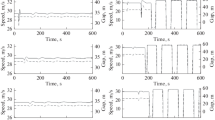Abstract:
The microscopic car-following model by Bando et al. [1-4] is extended by incorporating multi-vehicle interactions. It is shown that the reaction to more than one vehicle ahead leads to a stabilization of the dynamical behavior, i.e. the stable region increases. Still the fundamental macroscopic properties of traffic, free flow and congested flow, are described. More important, due to the multi-anticipative driving behavior driving in narrow platoons is forced such that a third fundamental property of traffic flow, the so-called synchronized flow [5], is modeled as well.
Similar content being viewed by others
Author information
Authors and Affiliations
Additional information
Received: 23 March 1998 / Accepted: 3 August 1998
Rights and permissions
About this article
Cite this article
Lenz, H., Wagner, C. & Sollacher, R. Multi-anticipative car-following model. Eur. Phys. J. B 7, 331–335 (1999). https://doi.org/10.1007/s100510050618
Issue Date:
DOI: https://doi.org/10.1007/s100510050618




